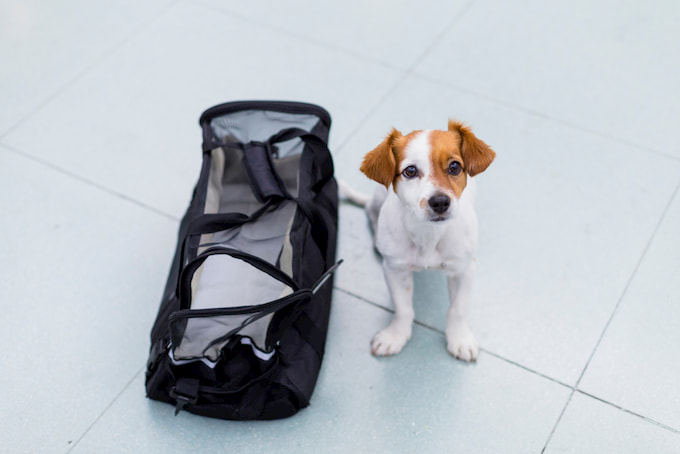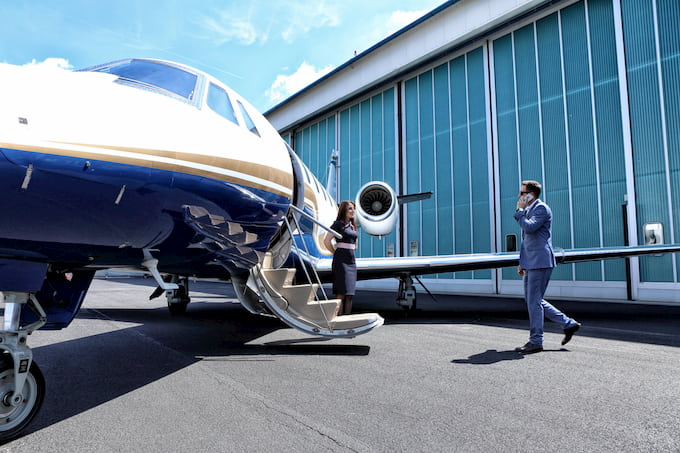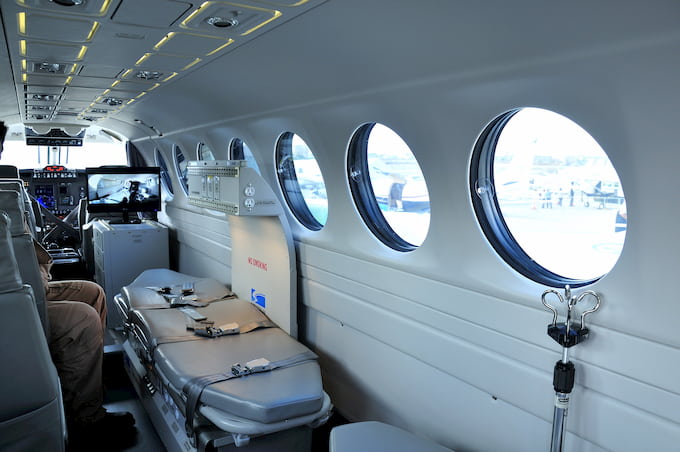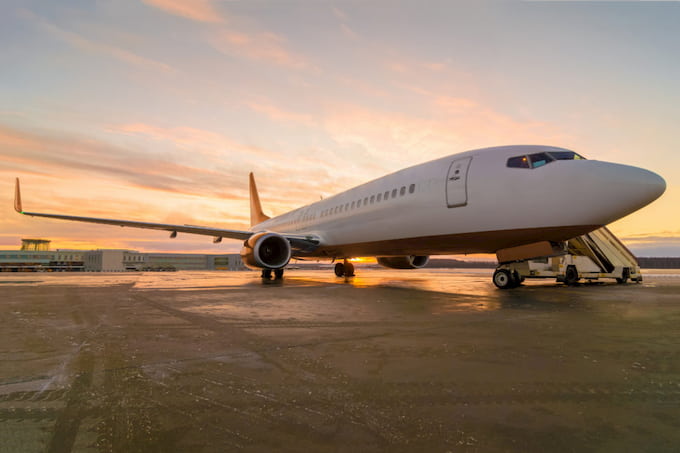Private Jet Charter: a Definitive Guide for 2025
10 Things You Need to Know

Guess how many people travel on private jets.
Any ideas?
In Europe alone, over 70,000 private jets take-off every month.
When thinking of private jets, often people think of aircraft owned by the rich and famous. In reality however, private travel is a powerful tool which is used by a much larger audience - especially when considering charter options.
But what does chartering a jet actually mean?
Private jet charter is the renting of an aircraft from a third party, for the purpose of travelling from A to B.
In this guide we’re going to cover all the things to consider when chartering an aircraft:
- How much does flying by private jet cost?
- What is an empty leg?
- What is an Aircraft Operator?
- What is an Aircraft Broker?
- Travelling with Pets
- The Private Jet Experience
- Buying vs Renting an Aircraft
- Medical Evacuation Flight
- Group Charters
- How can I book a flight?
- Conclusion
Feel free to click through to the relevant section!
How much does flying by private jet cost?
Pricing for private jets depends entirely on the requirements of a particular journey. As a rule of thumb, the cost of most jet-engined aircraft starts at roughly £2.500 ($3.000) per flight hour.
For slightly less luxurious, simple A to B trips, small planes can also be rented for as little as £1.275 ($1.550) per flight hour.
| Aircraft Category | Example Aircraft | Range | Price per Hour |
|---|---|---|---|
| Piston | Diamond DA42 | Up to 4 hours | £1,275 / $1,550 |
| Turbo-Prop | King Air 200 | Up to 4.5 hours | £1,700 / $2,050 |
| Entry Level Jet | Citation Mustang | Up to 2.5 hours | £2,500 / $3,000 |
| Light Jet | Citation CJ2 | Up to 3.5 hours | £2,975 / $3,600 |
| Super Light Jet | Citation XLS | Up to 4 hours | £3,400 / $4,100 |
| Midsize Jet | Hawker 800XP | Up to 5 hours | £3,825 / $4,700 |
| Super Midsize Jet | Citation Sovereign | Up to 6 hours | £4,250 / $5,200 |
| Heavy Jet | Challenger 604 | Up to 7 hours | £5,100 / $6,200 |
| Ultra Long Range | Global 6000 | Up to 10.5 hours | £6,000 / $7,300 |
| Airliner | Airbus A320 | Up to 7 hours | £12,750 / $15,400 |
When receiving a charter quote, it usually includes the following cost components:
- The positioning of the aircraft to the point of departure
- All direct fuel and maintenance costs
- Crew (pilots and flight attendant) costs, including overnight hotel accommodation if necessary
- Catering (what type of catering depends on the size of the aircraft)
- Landing, handling and parking fees for the aircraft
Costs which are never included in a charter quotation are:
- Additional ground transportation costs (taxis, limousines etc.)
- Special catering requirements outside a typical catering budget
- De-icing costs (usually only necessary in the winter)
What is an empty leg?
An empty leg is a repositioning flight of a private aircraft, required to move the aircraft to its contracted starting point.
Example: if you book a private jet from Berlin, but the aircraft is currently in Rome, an empty leg flight is created from Rome to Berlin.
The myth that empty leg flights can be booked for less than the cost of an airline ticket is often touted in the media, but it is just that: a myth.
In reality, empty leg flights are considerably cheaper than conventional charter flights - but the discount is roughly 50-60% off the normal charter rate.
The right to sell the empty leg belongs to the aircraft operator - unless the party chartering the aircraft explicitly requests the inclusion of the empty leg in the charter contract (usually at an additional cost).
Empty legs require a lot of flexibility, as they are always subject to a primary charter. If the flight which created the empty leg is cancelled for some reason, the empty leg will no longer be available at the discounted rate.
For this reason, although it’s always worthwhile to monitor empty legs for great deals, we strongly recommend conventional charter for critical “I must be at this place at this time” missions.
What is an Aircraft Operator?
In business aviation there are two major stakeholders: aircraft owners / operators, and private jet brokers.
Aircraft operators are licensed to operate by means of an Aircraft Operator’s Certificate (AOC), which allows them to transport passengers commercially. Compared to non-commercial private flights, commercial aircraft operations are subject to a range of additional regulatory requirements. Simply put: regulators ensure that there are higher safety margins in place for paying passengers.
I saw a [insert large aircraft type] just depart from [insert airport name] airport, why can’t my chartered aircraft fly out of there too?
The aircraft you saw was most likely operated as a private non-commercial flight. The more stringent safety margins required for chartered aircraft could not be guaranteed at that airport.
It is not unknown for some private aircraft owners to try to carry commercial passengers without the required certification, masking these as “private” flights. While these flights may be cheaper, this is a highly illegal practice - similar to a private individual using their private car to run a taxi business: the required standards are lower, the insurance requirements are not met, and there is very little consumer protection if something goes wrong.
For this reason, AlbaJet only books aircraft from reputable, certified aircraft operators that have not only demonstrated compliance with regulatory requirements, but also have a proven and spotless safety record.
Tip: when chartering an aircraft, always ask to see a copy of the aircraft operator’s certificate and aircraft insurance.
What is an Aircraft Broker?
Historically, aircraft brokers were simply a proxy/agent between customers wishing to book a private jet, and private jet operators. In this traditional sense, AlbaJet also works as a “broker”, as we do not own any jets ourselves.
The value-add of the broker is the ability to find the most suitable aircraft for any particular mission, meeting the customer’s requirements at the best possible price.
But I have booked directly for many years with aircraft operator X, why should I book through AlbaJet?
Unlike in the airline world, where aircraft generally fly the same scheduled routes, in business aviation aircraft are constantly “floating around” in a seemingly random way.
Let’s imagine the following scenario: a client lives in Berlin, Germany - and would like to fly to London. His / her first instinct may be to contact local aircraft operators in the area directly, as they would probably always be cheapest - right?
Wrong. More often than not, there may be an operator with an aircraft already in the Berlin area, that needs to fly back to London - or in that general direction, anyway. The local operator, on the other hand, would need to “empty leg” the aircraft back to Germany once they get to London, which increases the price substantially.
This is where the role of AlbaJet, as a private jet broker, becomes important: rather than just blindly booking the most local operator, we use proprietary bidding technology to compare all the available aircraft on the market and then select the most suitable options for you.
Travelling with Pets

Flying with pets on a commercial airline flight can be a stressful ordeal for both the pet and its owner: aircraft holds can be cold, loud, insufficiently pressurised, and generally uncomfortable.
Luckily, many private aircraft operators are very welcoming towards pets - they can even travel in the cabin, so that they never have to leave their owner’s side.
The Private Jet Experience

First-time private jet users often have a lot of questions - they are unsure about what they should expect. When do I have to be at the airport? Do I have to go to the main terminal? Will I get food onboard? Let’s have a look at some of these questions one by one:
When do I have to be at the airport?
At most airports it is sufficient to arrive 20 minutes before the scheduled departure time. We do recommend however that you always allow some additional time for contingencies - such as traffic jams on the way to the airport.
Where do I have to go?
The meeting point varies from airport to airport. AlbaJet customers receive precise directions, including a google maps navigation link - this is contained within your flight briefing document. Usually, private jet flights depart from a dedicated terminal called an FBO (“Fixed Base Operator” - there are some exceptions to this, especially in southern Europe). At the FBO, you will be greeted by your aircraft crew and escorted to the aircraft.
Will I be served food onboard?
Short answer: on most flights, yes. Catering very much depends on the length
of the flight and on the size of the aircraft.
As a rule of thumb: small propellor aircraft usually have no catering,
turboprops and light jets will offer snacks and drinks, medium-sized jets will
have cold catering, and heavy jets will offer hot catering.
Tip:
be sure to disclose any dietary requirements well in advance of your flight!
What if I am late for my flight?
We strongly recommend being on time: aircraft operators are contracted to depart at the agreed time - most will be able to wait up to 30 minutes for delays, but this is by no means guaranteed!
How do I pay for my jet?
The most convenient and cost-effective way to pay for a private jet flight is
via bank transfer. Alternatively, it is possible to pay using all major credit
cards - however, this will incur a transaction fee.
Last-minute flights will require either a temporary credit card hold, or a
credit card payment in order to secure the aircraft.
AlbaJet also accepts Bitcoin payments.
What documents do I need?
Much like flying on a commercial airliner, a passport is a vital document to
be carried by all passengers.
Within the Schengen zone, a photo-ID may
be sufficient - however, please consult us before travelling.
Visa and immigration requirements are the same as for commercial flights.
Are prices per seat, or for the whole aircraft?
Charter prices are typically for the entire aircraft.
There are various seat-sharing options available (such as JetSmarter):
however, while these can be significantly cheaper, they come at the cost of
much-reduced flexibility - the aircraft will depart on a fixed schedule, and
you will share the aircraft cabin with strangers.
Buying vs Renting an Aircraft
Owning your own aircraft is often considered to be the ultimate luxury. But at
what point does buying an aircraft make financial sense, compared to
chartering? Most private jets cost in the region of
3 to 40 Million US Dollars, dependent on size and age. A brand-new
Learjet 75
for example, comes with a price-tag of $13.8 million.
Annual costs (both
fixed and variable) come on top of this.
Our recommendation: buying an aircraft can make sense if a) you can use it - and expense it - as a business asset, b) you often fly the same - or similar - route and mission profiles, and c) you fly for hundreds of hours a year.
In most cases, chartering an aircraft will be significantly cheaper, and will allow you the flexibility to fly on the most suitable aircraft for each particular mission.
What is a medical evacuation flight?

A medical evacuation (or ambulance) flight is a flight conducted to transport a seriously ill patient by air to a receiving medical facility.
When a person is deemed unfit to travel on a scheduled flight, a medical evacuation (or Medevac) flight may become necessary.
Medevac flights are conducted on specially-equipped aircraft, and typically include two pilots, a physician and a flight nurse. These aircraft can either be in a single or double stretcher configuration.
Before a medical flight can be performed, it is important to provide all available medical documentation. This documentation will be assessed by a specialised doctor, who will have the final word regarding the fitness of the patient for transportation.
Ambulance flights can be performed worldwide, and can be tailored to all requirements.
Please call us for a free consultation: +44 (0)20 8089 6288.
Group Charter Flights

Travelling with more than 15 passengers? You will probably need an aircraft larger than most private jets.
For larger groups, a chartered aircraft can often be significantly cheaper than a commercial flight - and of course you can also choose the departure and destination airports at the times that suit you best. Group charters are ideal for sports teams, musicians travelling with technicians/bands, festival/conference attendees, and excursions organised by travel agents.
Some examples of aircraft suitable for group charters:
- 0-50 passengers: Fokker 50 or BAe 146
- 50-100 passengers: Fokker 100 or Embraer 190
- 100-180 passengers: Airbus A320 or Boeing 737
- 180+ passengers: Airbus A330, A340, Boeing 747, 757
To get an idea of the price, we recommend using the AlbaJet online price calculator.
How can I book a flight?
Booking a private jet is a simple process - however, there are 5 important steps which may be new to those chartering an aircraft for the first time:
-
Step 1
get an instant cost-estimate online and request live market prices -
Step 2
receive a quote summary, detailing the most suitable aircraft for your trip -
Step 3
choose which option you would like to book, and provide your billing address -
Step 4
sign your charter contract and execute payment (see “How do I pay for my jet?”) -
Step 5
provide the passport details of all travelling passengers (this is required for the passenger manifest)
Be sure to communicate any special requirements (e.g. catering, time restrictions, ground transfers, aircraft size) as early as possible: this will ensure that these are catered for.
Conclusion
Chartering an aircraft for the first time can seem like a daunting task, but it needn’t be.
Not sure where to get started? Try our free online cost-estimator, and then request a non-binding quote for your trip.